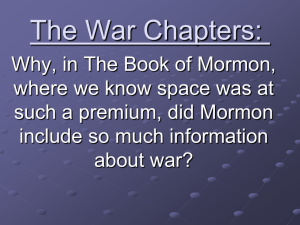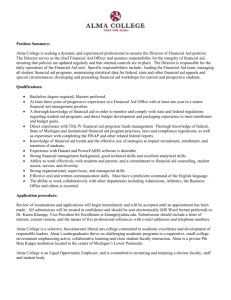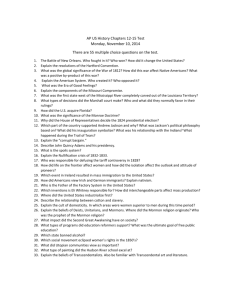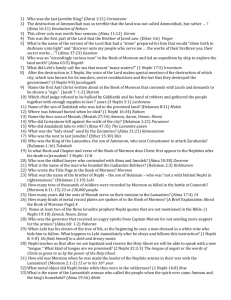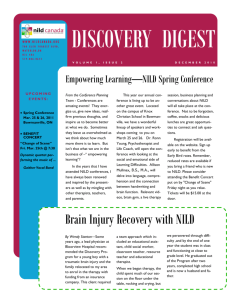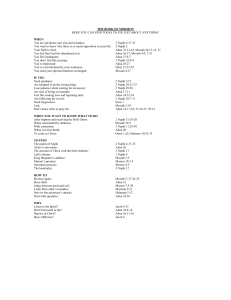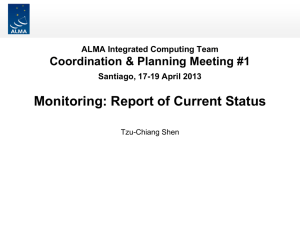Mesoamerican Setting for the Book of Mormon
advertisement
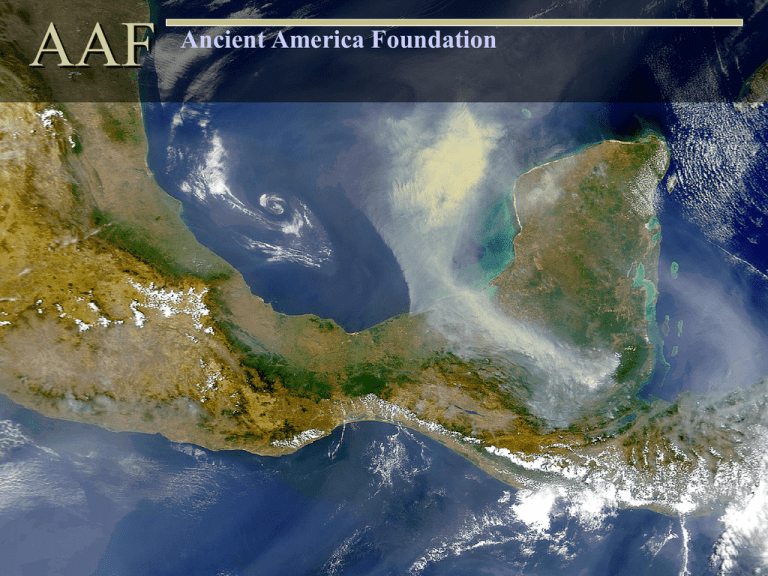
AAF Ancient America Foundation AAF Ancient America Foundation Why Mesoamerica Fits Book of Mormon Geography By Alan Miner AAF Ancient America Foundation A Mesoamerican Setting for the Book of Mormon The name "Mesoamerica" is a term used to identify the heartland of a number of significant pre-Columbian cultures. The area of Mesoamerica encompasses many of the states of southern Mexico, and most of the countries of Central America, including Guatemala, Belize, El Salvador, Honduras, Nicaragua, and part of Costa Rica. It is bounded on the north by the Gulf of Mexico, on the east by the Caribbean Sea, and on the south and west by the Pacific Ocean. The unique geographical and cultural characteristics of the "promised land" central to the story of the Book of Mormon favor the area of Mesoamerica. The slides that follow give evidence in support of this premise. AAFMosiah Flees to Zarahemla Ancient America Foundation True Nephite’s North North Gulf of Mexico (Sea East) Zarahemla Santa Rosa Pacific Ocean (Sea West) Land of Nephi Guatemala City Kaminaljuyu AAF Ancient America Foundation The Distance Between the Land of Nephi and Zarahemla Around 61 percent of the whole Book of Mormon story take place in and around Nephi and Zarahemla. Alma the Elder's group, with their flocks and herds, took a few more than 21 days to traverse the distance between these two lands. This means that 61 percent of the Book of Mormon (about 600 years of history) probably took place within a 200 to 400-mile radius. All the necessary population centers, cultures, written languages, bodies of water, wilderness areas, and strategic landmarks such as the narrow neck of land had to be circumscribed within or close to that 400-mile radius. These dimensions fit the area of Mesoamerica. Zarahemla Santa Rosa Land of Nephi Guatemala City Kaminaljuyu AAF Ancient America Foundation Multiple Advanced Cultures The Jaredite culture lived from about 2500 to 300 B.C. The Lamanite, Nephite, and Mulekite cultures flourished between 600 B.C. and 400 A.D. The Lamanite culture continued after 400 A.D. The main place where corresponding cultures and population centers flourished during these times was in Mesoamerica. The Mesoamerican cultures date from approximately 2500 B.C. to 1500 A.D. These civilizations include the Lowland and Highland Maya, the Olmec culture, the Zapotec culture, and the Valley of Mexico core culture. AAF Ancient America Foundation Written Language in Mesoamerica The Nephites kept written records: that is why we have the Book of Mormon. We know that in the last battles between the Nephites and Lamanites, the Nephites wrote to the Lamanite king and received a response (Mormon 6:2-3). At present, it seems that the only place on the continent where there was a phonetic written language at the time of the Book of Mormon was in Mesoamerica. AAF Mesoamerica Archaeological Sites Ancient America Foundation Ecab Ake Tancah Chichen Itza Panuco La Quemada San Luis Potosi Acanceh Cerro de las Mesas Chicanna Hormiguero Matacapan Choluca Mezcala Tlaxcala Xochipala Tilantongo Zaculeu Santa Leticia Tulum Xpuhil Rio Bec El Mirador Nakbe Comalcalco Palenque Chiapa de Corzo Uaxactun Tikal Chinkultic Chilpancingo Becan Yaxchilan Quirigua Copan Tazumal Ceren At present, 90% of the significant culturally advanced archaeological sites from Book of Mormon times are located in Mesoamerica AAF Ancient America Foundation Bodies of Water in the Book of Mormon Within the Book of Mormon, the following bodies of water must be accounted for: the river Sidon (Alma 2:15), the waters of Sidon, the waters of Mormon (Mosiah 18:8), the waters of Sebus (Alma 26:34), the-land of pure water (Mosiah 23:4), the land of many waters (Mosiah 8:8), the place where the sea divides the land (Ether 10:20), the waters of Ripliancum (Ether 15:8), the large bodies of water in the land which was northward, the sea south (Helaman 3:8), the sea north (Helaman 3:8), the sea west (Alma 22:27), and the sea east (Alma 22:27). Mesoamerica has bodies of water which fit the descriptions in the Book of Mormon. The Promised Land was apparently rugged enough Ancientwilderness Americaareas Foundation that at least the following must be accounted for: an unspecified wilderness that Nephi, Mosiah, Limhi, Ammon, and Alma wandered in for many days; a west wilderness (Alma 22:28), a wilderness of Hermounts (Alma 2:37), a south wilderness (Alma 22:31), a north wilderness (Alma 22:27), narrow strip of wilderness which "ran fromenough that at least the The aPromised Land was apparently rugged the sea east evenwilderness to the sea west" and following areas(Alma must22:27), be accounted for: an unspecified an east wilderness (Alma 25:5). More significantly, wilderness that Nephi, Mosiah, Limhi, Ammon, and Alma the term wilderness seems to be equated with wandered in for many days; a west wilderness (Alma 22:28), a mountainous terrain. Mesoamerica is the only place wilderness Hermounts (Alma a south wilderness (Alma on the continent of with a mountain range2:37), running (Alma 22:27), a narrow strip of from 22:31), an east seaa tonorth a west wilderness sea. AAF Wilderness Wilderness Areas and Mountain Ranges in Mesoamerica wilderness which "ran from the sea east even to the sea west" (Alma 22:27), and an east wilderness (Alma 25:5). More significantly, the term wilderness seems to be equated with mountainous terrain. Mesoamerica is the only place on the continent with a mountain range running from an east sea to a west sea Ancient America Foundation Small AAF Neck, Narrow Neck, Narrow Pass, or Narrow Passage In Mesoamerica, a narrow travel corridor stretches from the Pacific coast of Guatemala through the Isthmus of Tehuantepec to the Atlantic coast of Veracruz, Mexico. Almost all north-south land traffic and trade passed through this corridor from ancient (Jaredite) times until well past the end of Book of Mormon times (420 A-D.). The Book of Mormon scriptures make reference to "a small neck of land" (Alma 22:32), a narrow neck of land" (Alma 63:5; Ether 10:20), "a narrow pass" (Alma 50:34; 4 Nephi 3:5), and "a narrow passage" (4 Nephi 2:29) all of which seem to be of strategic importance. These "small neck - narrow neck - narrow pass narrow passage" terms are mentioned from Alma's time in (90 B.C.) to Mormon's time in 362 A.D. They are also linked to the Jaredite times. What would make these geographical areas strategically important over so many years? AAF Ancient America Foundation If you are interested in Book of Mormon Research dealing with Mesoamerica, you are invited to visit our website at http://ancientamerica.org . Become a member and receive our weekly newsletter keeping you abreast of Book of Mormon Research. Neither the Ancient America Foundation nor this web site is endorsed by the Church of Jesus Christ of Latter-day Saints.
